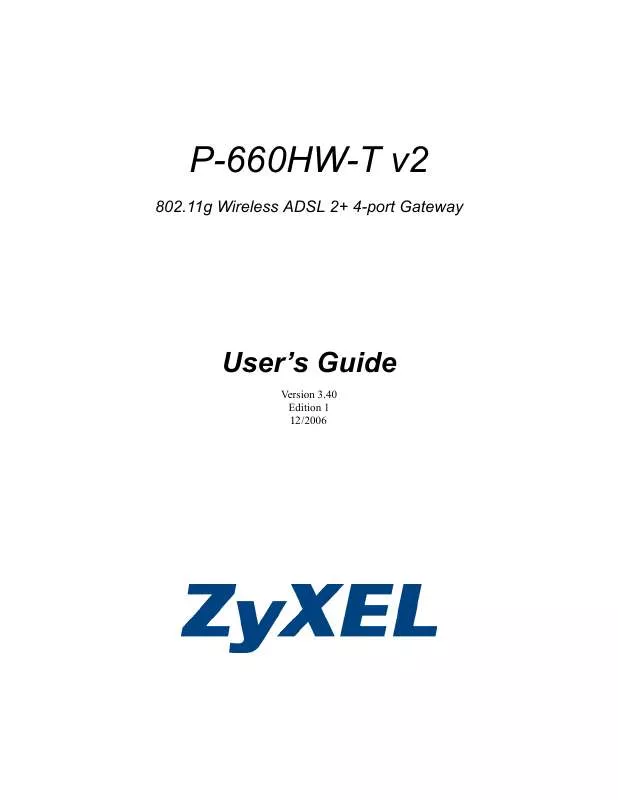User manual ZYXEL P-660HW-T V2 VERSION 3.40
Lastmanuals offers a socially driven service of sharing, storing and searching manuals related to use of hardware and software : user guide, owner's manual, quick start guide, technical datasheets... DON'T FORGET : ALWAYS READ THE USER GUIDE BEFORE BUYING !!!
If this document matches the user guide, instructions manual or user manual, feature sets, schematics you are looking for, download it now. Lastmanuals provides you a fast and easy access to the user manual ZYXEL P-660HW-T V2. We hope that this ZYXEL P-660HW-T V2 user guide will be useful to you.
Lastmanuals help download the user guide ZYXEL P-660HW-T V2.
Manual abstract: user guide ZYXEL P-660HW-T V2VERSION 3.40
Detailed instructions for use are in the User's Guide.
[. . . ] P-660HW-T v2
802. 11g Wireless ADSL 2+ 4-port Gateway
User's Guide
Version 3. 40 Edition 1 12/2006
P-660HW-T v2 User's Guide
Copyright
Copyright © 2006 by ZyXEL Communications Corporation. The contents of this publication may not be reproduced in any part or as a whole, transcribed, stored in a retrieval system, translated into any language, or transmitted in any form or by any means, electronic, mechanical, magnetic, optical, chemical, photocopying, manual, or otherwise, without the prior written permission of ZyXEL Communications Corporation. Published by ZyXEL Communications Corporation. All rights reserved.
Disclaimer
ZyXEL does not assume any liability arising out of the application or use of any products, or software described herein. [. . . ] An "extension number", called the "TCP port" or "UDP port" identifies these protocols, such as HTTP (Web), FTP (File Transfer Protocol), POP3 (E-mail), etc. For example, Web traffic by default uses TCP port 80. When computers communicate on the Internet, they are using the client/server model, where the server "listens" on a specific TCP/UDP port for information requests from remote client computers on the network. For example, a Web server typically listens on port 80. Please note that while a computer may be intended for use over a single port, such as Web on port 80, other ports are also active. If the person configuring or managing the computer is not careful, a hacker could attack it over an unprotected port.
Chapter 9 Firewalls
139
P-660HW-T v2 User's Guide
Some of the most common IP ports are:
Table 48 Common IP Ports
21 23 25 FTP Telnet SMTP 53 80 110 DNS HTTP POP3
9. 4. 2 Types of DoS Attacks
There are four types of DoS attacks: 1 Those that exploit bugs in a TCP/IP implementation. 2 Those that exploit weaknesses in the TCP/IP specification. 3 Brute-force attacks that flood a network with useless data. 5 "Ping of Death" and "Teardrop" attacks exploit bugs in the TCP/IP implementations of various computer and host systems. · Ping of Death uses a "ping" utility to create an IP packet that exceeds the maximum 65, 536 bytes of data allowed by the IP specification. The oversize packet is then sent to an unsuspecting system. · Teardrop attack exploits weaknesses in the re-assembly of IP packet fragments. As data is transmitted through a network, IP packets are often broken up into smaller chunks. Each fragment looks like the original IP packet except that it contains an offset field that says, for instance, "This fragment is carrying bytes 200 through 400 of the original (non fragmented) IP packet. " The Teardrop program creates a series of IP fragments with overlapping offset fields. When these fragments are reassembled at the destination, some systems will crash, hang, or reboot. 6 Weaknesses in the TCP/IP specification leave it open to "SYN Flood" and "LAND" attacks. These attacks are executed during the handshake that initiates a communication session between two applications.
Figure 79 Three-Way Handshake
140
Chapter 9 Firewalls
P-660HW-T v2 User's Guide
Under normal circumstances, the application that initiates a session sends a SYN (synchronize) packet to the receiving server. The receiver sends back an ACK (acknowledgment) packet and its own SYN, and then the initiator responds with an ACK (acknowledgment). After this handshake, a connection is established. · SYN Attack floods a targeted system with a series of SYN packets. Each packet causes the targeted system to issue a SYN-ACK response. While the targeted system waits for the ACK that follows the SYN-ACK, it queues up all outstanding SYN-ACK responses on what is known as a backlog queue. [. . . ] 4 Click Add to move the IP address to the list of Allowed sites.
Appendix L Pop-up Windows, JavaScripts and Java Permissions
337
P-660HW-T v2 User's Guide Figure 191 Pop-up Blocker Settings
5 Click Close to return to the Privacy screen. 6 Click Apply to save this setting.
JavaScripts
If pages of the web configurator do not display properly in Internet Explorer, check that JavaScripts are allowed. 1 In Internet Explorer, click Tools, Internet Options and then the Security tab.
338
Appendix L Pop-up Windows, JavaScripts and Java Permissions
P-660HW-T v2 User's Guide Figure 192 Internet Options (3)
2 Click the Custom Level. . . 4 Under Active scripting make sure that Enable is selected (the default). [. . . ]
DISCLAIMER TO DOWNLOAD THE USER GUIDE ZYXEL P-660HW-T V2 Lastmanuals offers a socially driven service of sharing, storing and searching manuals related to use of hardware and software : user guide, owner's manual, quick start guide, technical datasheets...manual ZYXEL P-660HW-T V2


